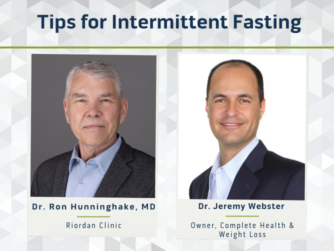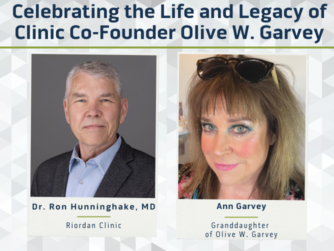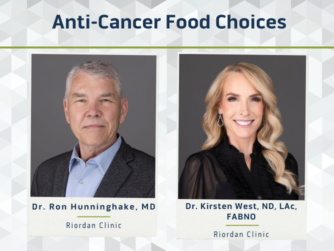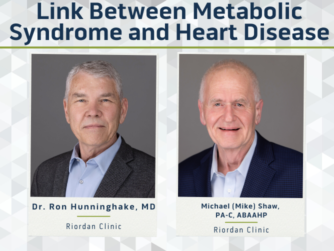In this episode of the Real Health Podcast, Riordan Clinic’s Chief Medical Officer Dr. Ron Hunninghake, MD, is joined by Dr. Dustin Moffitt, ND, to discuss the causes and treatments for chronic pain. The underlying causes of chronic pain can be surprising. Non-invasive treatments are available and can often bring patients relief.
Watch the Video
https://www.youtube.com/watch?v=HSs0C8sgu54
Thank You to this Episode’s Sponsor
Riordan Clinic Nuttrient Store
Links
Riordan Clinic: https://riordanclinic.org/
Health Hunters: https://riordanclinic.org/wp-content/uploads/2022/11/Riordon_HealthHunters_Dec22_Newsletter_Digital-2.pdf
Episode Transcript
Disclaimer: The information contained on the Real Health Podcast and the resources mentioned are for educational purposes only. They are not intended as and shall not be understood or construed as medical or health advice. The information contained on this podcast is not a substitute for medical or health advice from a professional who is aware of the facts and circumstances of your individual situation. Information provided by hosts and guests on the Real Health Podcast, or the use of any products or services mentioned does not create a practitioner patient relationship between you and any persons affiliated with this podcast.
Introduction: This is the Real Health Podcast brought to you by Riordan Clinic. Our mission is to bring you the latest information and top experts in functional and integrative medicine to help you make informed decisions on your path to real health.
Ron Hunninghake: Well, welcome everyone. I’m Dr. Ron Hunninghake, and today we’re doing our Real Health Podcast today with Dr. Dustin Moffitt from up in Hayes, Kansas. He’s part of our Riordan Clinic team. So Dr. Moffitt, welcome to a Real Health Podcast.
Dustin Moffitt: Thanks for having me.
Ron Hunninghake: So I think many of you who have listened in before have had the opportunity to hear about what Dr. Moffitt does in the area of resolving chronic pain. So we wanted to talk about that, the meaning of pain, and what can be done to actually get to the root cause. So maybe, do you mind if I call you Dustin, doctor?
Dustin Moffitt: No, that’s fine.
Ron Hunninghake: So Dustin, going back to your early naturopathic education, where did you first start getting interested in pain and the resolution of chronic pain?
Dustin Moffitt: Attending CE events, which I did throughout medical school just because it was fun, and I called it nerd-out material. It allowed me to see outside of the standard curriculum. And in one of the conferences I actually went to a talk by Dr. Tina Moore, who is a chiropractor and a naturopathic doctor, and she is one of the physicians that has helped train me in my skills, one of the many. And she originally caught my eye. She just kept going on left and right about needling therapies and helping people with their chronic pain and regenerate tissue. And at that point I hadn’t heard anything much about it because I was either in my first or second year of medical school. So that struck my interest.
Then later on, we actually learned more about it through our minor surgery class. One of our professors that was doing a lot of regenerative therapies, mostly dextrose prolotherapy, and then I did several clinic rotations also learning for that. And each time that I was introduced to it more and more, you get to see the case studies in patient presentation of them improving. And I myself was a chronic pain patient for a while due to an injury and it actually helped me myself, and a lot of patients like that relatability, that the doc not only has treated a lot of patients, but also has been through it themselves and knows what it feels like to be the patient on the table. And really that’s just what stemmed everything for me.
Ron Hunninghake: So really what we’re focusing on in this presentation is chronic pain, because for many people, the chronic pain diagnosis, people will get that diagnosis and then the thinking stops. There’s no really discussion of what’s the root cause of the chronic pain. So from this training that you had, could you help our audience understand what you learned and how it can help them correct these underlying causes of chronic pain?
Dustin Moffitt: Usually a chronic pain is due to a chronic injury. It’s one that has never fully progressed through the wound healing cascade, whether it be due to poor nutrition, high inflammatory loads, environmental toxins, food allergies, autoimmune conditions, poor thyroid function, poor hormones for growth factors for driving bone, and then just generalized aging. Next up would be, like we say, a lot of farmers, ranchers, and oil workers around here, not to be specific to just them, but there’s numerous injuries. They get knocked sideways by a cattle, they’re jumping out of high equipment all the time, off of tractors, implements, and it’s through those, that repetition of injury, you’re going to see scar tissue build up. The more scar tissue that builds up, the more avascular an area becomes, which means that they’ve lost the blood flow. And without proper blood flow and oxygenation, we do not get proper healing. So with regenerative injection therapies, we have the ability to step into allowing the body to reenter that wound healing cascade.
Ron Hunninghake: What’s interesting, I think a lot of people who have chronic pain have gotten one type of an injection or another, most of them involving steroids. How is regenerative injections, how are they different than just a steroid shot?
Dustin Moffitt: So a steroid’s primary action is to be a very strong anti-inflammatory. So corticosteroids will stop all inflammatory process, which in an acute area… So I tell my patients, the only time I like a steroid in an area is when it is red hot and extremely swollen beyond a controllable point. A little bit of inflammation is okay. Whether or not we’re going to be contemplating reactive arthritis or a gouty arthritis or something of that sort. Bursitis, can it help? Yes. But there’s also a lot of literature that shows that with corticosteroid usage, it may increase the chances of a chronic injury, because it’s a very strong anti-inflammatory. And if you recall back to what the wound healing cascade, the very first part of that cascade is inflammation. Well, secondary to bleeding if there’s trauma. But inflammation is not all bad. Inflammation is there to tell your body there is something wrong.
And of course if you whack your elbow up against something and get a bruise, it’s going to get inflamed, it’s going to get bruised, it’s going to start changing colors. The changing in the colors is the initiation of that remodeling phase coming on. And after we’ve gone through the remodeling phase, we’re going to step into the regeneration phase, which is where regenerative medicine comes in. And I always like to refer to regenerative medicine as the latter. So prolozone is something that you’ve done for a long time. It includes usually a local anesthetic and some ozone therapy introduced into the area of chronic illness or chronic pain to stimulate some healing. I like to say that it acts like hydrogen peroxide does on a wound.
Then you go up that ladder, you get dextrose prolotherapy. Then you get platelet rich plasma therapy. And then we can break it down even further into exosomes, Wharton’s jelly, and then stem cell product would be at right now at the highest portion of the ladder. So the higher you go up the ladder, the higher and stronger the effect is, but that does not mean that any chronic injury just needs to go straight to stem cells. Still the majority of injections that I do are dextrose prolotherapy. It’s a pretty close call on the amount of dextrose that we do versus platelet rich plasma. But prolotherapy is not to be looked over. It still helps heal a lot of injuries.
Ron Hunninghake: So again, for the sake of our audience, I think most people, when they have chronic pain, they think of it as this is the illness, the chronic pain. But what I hear you saying is that chronic pain is really just a manifestation of the wound healing process being disrupted or interrupted and they have not been able to complete normal wound healing. And that these therapies that you’re talking about actually restart or reboot the healing process in a more consecutive manner, such that the healing actually takes place. So your job is not to just really, quote, treat the pain, you’re just trying to heal the underlying cause of the pain.
Dustin Moffitt: And if you’ll see coming up in the next Real Health Hunter article, we’ve got a patient testimony that her addiction to pain reducing medications such as opioids was not based because she was addicted to them. It was based because the pain never was resolved. You take care of the pain, you take care of that addiction, because wasn’t the person that’s addicted to it. Their body needed the relief. Because what does chronic pain do? What do we see an uptake in when there’s people in chronic pain? Depression. So if you have family members that are dealing with depression, you need to get them treated for their pain, even if it’s not something that’s in the forefront of their mind. If you notice that they’re complaining about a typical area, let’s say their low back, that is very persistent, and you notice depression in them, that would be something that I would advise getting treated, because they go hand in hand. The brain and the body connect very, very well, and if one is one of them is suppressed, the other one follows suit.
Ron Hunninghake: Yeah, I’ve always felt that depression was a kind of psychological pain.
Dustin Moffitt: In the Medscape articles… Well, Medscape is just a platform, but there have been new literature studies that just came out that related that… I don’t remember what percentile, but a very high percentile of depression is correlated to inflammation. What is pain? Pain is inflammation.
Advertisement: There’s a lot more to this conversation and it’s coming up right after a quick break. Today’s podcast is brought to you by LivOn Labs, makers of liposomal vitamins and supplements. LivOn uses a liposomal encapsulation technology to protect nutrients from destruction in the digestive system. This allows for more efficient delivery of essential vitamins and nutrients. Choose from various supplements that support health and wellbeing, such as Liposphere vitamin C, magnesium, glutathione, and more. To learn more visit livonlabs, that’s L-I-V-O-N labs.com.
Ron Hunninghake: And inflammation is the body’s attempt to fix the problem. But if it doesn’t get completely fixed, then it becomes a chronic inflammatory signal that patients need to take a different course of action. And then in the past, the hope was is that if you gave it enough time, it would heal on its own. But what I hear you saying is that a lot of people get stuck in chronic inflammation because the wound itself has not healed, and the methods that you’re talking about, the one that interests me the most is this wound healing cascade, that there’s a sequence of events that needs to happen. And if they don’t happen, the wound does not get healed.
Dustin Moffitt: Well, and secondary to what we said about the corticosteroid shots doing that, what is some of the most over-the-counter used medications? Non-steroidal anti-inflammatories. And I believe that it is part of everybody’s usage. As soon as you bump your toe or something and it hurts, what do people take? They take aspirin, they take Tylenol, ibuprofen, et cetera. I know Tylenol’s not non-steroidal, but any pain relievers, the more often you take anything that reduces the pain, not only in the inflammation, it reduces that inflammation, which reduces the healing, but it is remodulating how your body interprets pain. So if you’re constantly slapping back pain, that means every little thing is going to be that much more painful. And we see that in our infants and children. Every new pain is the worst pain they’ve ever felt because their body is learning. Same thing, you’re inhibiting the learning of your body of how to deal with stressors in life by constantly suppressing it.
Ron Hunninghake: So again, in our culture we’ve made pain the illness, and pain is actually the… It’s really just a signal that the healing process has been disrupted. So in your training process, maybe we could go just a little bit more into when you begin to decide what to do to repair the healing process, what’s step one, what’s step two, et cetera?
Dustin Moffitt: Step one is getting in and getting the help that you need, whether it be to me for regenerative injection therapies, controlling chronic inflammation, controlling chronic illness of any other variety, going to physical therapy, massage, chiropractic. Those are often techniques that, for those that are not ready for injection therapies, because of course getting poked is not the easiest task. I call it more annoying than anything, about the amount of needling that needs to be done to address these chronic areas. But even those that report they don’t do well with needles, most of them do extremely well. So it is a doable therapy. But for those that aren’t ready for that commitment, I give them therapeutic exercises or refer them to PT, refer them to a chiropractor if it’s a place that is constantly under pain and pressure, massage therapy if there’s a lot of muscle involvement.
So the important part is just get the pain treated. Do not ignore it, because what are you going to wind up with down the road? Or if another factor of another chronic illness such as cancer comes on, is that pain that you are chronically dealing with going to allow your body to deal with that stress well enough to get over that hump? And I only use cancer as one op obstacle, but chronic illness, Epstein-Barr virus, fibromyalgia, chronic regional pain syndrome, these are all things that we see consistent basis with pain development. But when do we also start to see a fibromyalgia in chronic regional pain syndrome come on? Close to menopause in a lot of women, because those are not just persistent to women, but more common in them. Hormonal decline is a big portion of that.
I actually just did some talks on this, but in hormonal decline in aging, we see a reduction in what are called bone morphogenic proteins, BMPs. Bone morphogenic proteins are something that signal the cells in the body to lay down more cartilage and more bone tissue. And the first thing to go in arthritis is that articulating cartilage, the very smooth bone coating. So if we can increase those BMPs through hormonal replacement or supplementation, but there’s also factors that show that regenerative injection therapies increase the localized BMP response, which then increases mesenchymal stem cell recruitment to the area to intensify healing.
Ron Hunninghake: And this is fantastic, and I think our audience knows the importance of the whole functional medicine approach to any chronic illness. And what you said earlier on, namely that there’s a context to this chronic injury where there may be nutrient deficiencies, there could be other causes of chronic inflammation, the toxicity factors that are oftentimes overlooked, maybe a lack of sleep, mood disorders. All of these things are underlying factors that could interfere with the healing process. And then what you’re able to do in addition to addressing those underlying causes is to focus in locally where the pain is occurring and stimulate a more active healing response, exuberant healing response using the needling techniques.
So I’m just restating what we’ve been talking about because I think when people think of pain, they’re so… Pain, it tends to become an obsession, and all the patient wants is just, “Help me relieve the pain.” But to do that, you’ve got to treat these underlying causes. So over the long haul, when you have patients coming in, I know this is just going to be an average number, but what would you say your success rate is with people who have chronic pain using the combination of things that we’ve talked about in this podcast?
Dustin Moffitt: Pretty high. So it’s going to depend patient to patient. Obviously no therapy is ever going to be 100% And of course I can’t help everyone. But I would say depending on the region of what we’re treating, knees, we’re probably up in the upper 90s. Shoulders, same thing. And even those that have had multiple revisions to a SLAP lesion tear. Chronic neck pain, a lot of the times that crackle that you hear when you turn left and right, that’s the beginning of facet arthrosis or myofascial adhesions. Those are the most common ones. And neck pain, goodness, we’re pretty high up there on being able to resolve a lot of that. Hips are the most challenging, I would say. The way I describe them is they are a joint that is under a lot of pressure. We walk on them all the time, and the entire body weight is in that little bitty acetabulum, the hip socket.
Those are the ones that I would say we’ve been very blessed lately to get great results, but it can range anywhere from about 50 to 80%, yet again depending on the individual, and how severe that reaction is. But Ron, we’ve been very, very good at getting great results here. So a patient that I just saw yesterday, it’s too soon to tell what’s going on, but he has been seeing other providers for I think a year and a half or two years and has never once left an office feeling better. Matter of fact, a lot of times would feel aggravated, whether it be chiropractic care, physical therapy. He’s had surgical consults, but it’s not bad enough because they haven’t found anything. He was able to walk out of the clinic yesterday pain free.
Ron Hunninghake: And I can’t help but think how many cases of chronic narcotic addiction could be due to the fact that people feel like they just need to take a pain pill to try to deal with their pain, and if they would get the full scope of care that we’re talking about, how many cases of chronic narcotic addiction could be avoided. Dr. Moffitt, thank you so very much. This has been very enlightening, and I hope people will, that are in pain, take advantage of the services that you offer up there in Hayes. So thanks very much for being on Real Health Podcast.
Dustin Moffitt: Great. Thanks for having me.
Outro: Thank you for listening to the Real Health Podcast. If you enjoyed this episode, be sure to subscribe and leave us a review. You can also find all of the episodes and show notes over at realhealthpodcast.org. Also be sure to visit riordanclinic.org where you will find hundreds of videos and articles to help you create your own version of Real Health.





